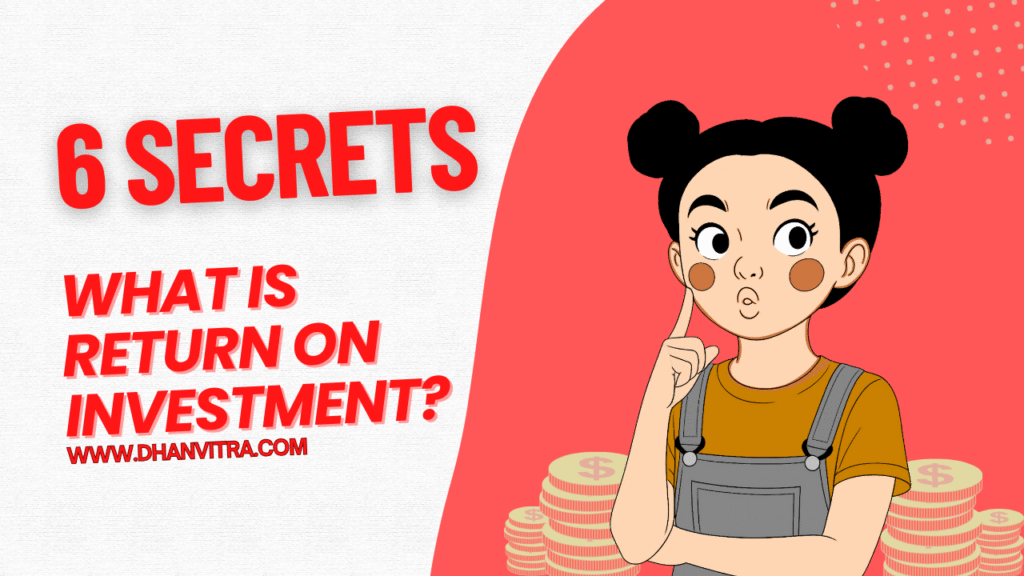
At Dhanvitra, we believe financial freedom isn’t just a dream—it’s a journey built step by step with smart money choices. Unlike chasing quick market gains, dividend investing rewards patience by offering you regular cash flow while your investments continue to grow in value.
If you’ve ever thought, “How do people earn money even while they sleep?”—dividends are one of the answers. By owning shares in companies that share their profits with investors, you can enjoy a reliable stream of passive income along with long-term wealth creation.
This blog, “Dividend Investing: 10 Secrets Every Beginner Must Know,” is designed especially for beginners who want to avoid costly mistakes and start building a strong financial foundation. Whether you’re planning for retirement, looking to supplement your income, or simply want to grow your wealth smarter, these 10 secrets will guide you step by step.
At Dhanvitra, our goal is simple: to make finance easy, practical, and actionable for everyone. So, let’s dive in and uncover how you can plant your very own “money tree” with dividend investing!
What Is Dividend Investing?
Dividend investing is one of the simplest yet most effective wealth-building strategies in the financial world. At its core, it means buying shares of companies that regularly share a portion of their profits with investors in the form of dividends. Instead of waiting for your stocks to rise in value and then selling them, you receive cash payments—usually every quarter—just for holding those stocks.
This method appeals to many investors globally because it blends stability with growth. For example, imagine you own a piece of a well-known company like Coca-Cola. Every three months, that company rewards you with a portion of its profits, no matter where you live. Over time, these payments can grow, giving you a steady stream of income in addition to the potential rise in the stock price.
Unlike speculative trading, dividend investing emphasizes patience, consistency, and the long-term performance of companies with proven business models. Think of it as owning a rental property—except instead of dealing with tenants, you’re quietly collecting cash from global corporations.
Table of Contents
Secret 1: Understand Dividend Yield Properly
Many beginners fall into the trap of chasing dividend yield without fully understanding what it means. Dividend yield is simply the annual dividend payout divided by the current share price, expressed as a percentage. For instance, if a company pays $5 annually per share and the stock trades at $100, the dividend yield is 5%.
The mistake comes when investors assume that a higher yield always means better returns. A company offering a 12% yield might look attractive, but in reality, it could signal financial trouble. Often, businesses raise dividend yields artificially because their share prices have fallen due to weak fundamentals. This is known as a “dividend trap.”
Instead of chasing high yields, investors should aim for sustainable ones—typically in the 2% to 6% range, depending on the region and sector. The most important question to ask is: Can the company maintain and grow this dividend in the future? That’s the key to building a reliable income stream.
Secret 2: Focus on Dividend Growth, Not Just Yield
A common misconception among new investors is that yield alone defines success. In reality, dividend growth is the real wealth multiplier. Imagine you bought a stock today with a modest 3% yield. If the company consistently increases its dividend by 7–10% each year, your yield on cost (the dividend compared to what you originally invested) will skyrocket over time.
For example, let’s say you invested in Johnson & Johnson two decades ago. Back then, its dividend yield looked modest. But because the company raised dividends consistently year after year, long-term investors now enjoy a double-digit yield on their original investment.
This is where the magic happens: growth turns small payouts into significant income streams. Instead of hunting for “instant gratification” through high yields, think of dividend growth stocks as seeds. They may start small, but with consistent nurturing, they grow into giant oak trees providing shade for decades.
Secret 3: Reinvest Dividends for Compounding Power
Einstein famously called compounding the eighth wonder of the world, and dividend reinvestment proves exactly why. When you reinvest your dividends back into buying more shares, those extra shares start generating dividends too. Over the years and decades, this snowballs into massive wealth creation.
Let’s simplify this with an example. Suppose you invest $10,000 into a stock yielding 4% annually. If you take the cash out each year, you earn $400 annually. But if you reinvest those dividends, your holdings increase, and the following year, you earn dividends not just on your original $10,000 but also on the reinvested portion. After 20 or 30 years, the difference between taking cash and reinvesting can mean hundreds of thousands of dollars.
Globally, many brokers and companies offer Dividend Reinvestment Plans (DRIPs) that automatically reinvest dividends for free or at low cost. It’s like a financial autopilot, silently multiplying your money while you focus on living your life.
Secret 4: Look for Dividend Aristocrats & Kings
If you want reliability in dividend investing, one of the smartest strategies is to focus on Dividend Aristocrats and Dividend Kings. These are elite groups of companies that have increased their dividends for decades—25 years for Aristocrats and 50+ years for Kings.
Why does this matter? A company that can pay and raise its dividend for decades has likely survived multiple recessions, wars, and market crashes. That kind of consistency shows strong management, stable profits, and a shareholder-friendly philosophy.
Take Procter & Gamble, for example, a Dividend King. This company has been paying and increasing dividends for more than 60 years. Imagine the peace of mind that comes from owning a business so resilient that it keeps rewarding investors even during tough times.
For global investors, Dividend Aristocrats aren’t limited to the U.S. Many countries have their own dividend champions. By focusing on these proven companies, you’re essentially betting on businesses that have mastered the art of rewarding shareholders over the long haul.
Secret 5: Avoid Dividend Traps
One of the most dangerous mistakes new investors make is falling into what’s known as a “dividend trap.” On the surface, a company offering a very high dividend yield might look like a golden opportunity. After all, who doesn’t want a 12% or even 15% return every year? But here’s the catch—if the dividend is unsustainably high, chances are the business is struggling. A company may raise its yield artificially when its stock price drops sharply, creating an illusion of higher returns.
For example, think about a sinking ship giving away free gold bars. The same applies to dividend traps. If a company’s financials are weak, it might eventually cut or cancel dividends altogether, leaving investors disappointed. Always look beyond the yield and study the fundamentals—check revenue trends, debt levels, and industry stability. It’s better to earn a steady 3–4% from a solid business than chase double-digit yields that vanish overnight.
Secret 6: Diversify Your Dividend Portfolio
Imagine relying only on one job for income. If you lose that job, your entire financial stability collapses. The same logic applies to dividend investing. Putting all your money into a single company or industry can be risky. For instance, if you only invest in oil companies and energy prices crash, your dividend income will take a heavy hit.
Diversification is your safety net. A strong dividend portfolio spreads investments across different sectors—technology, healthcare, utilities, consumer goods, and even international markets. This way, if one industry struggles, others can balance it out. Global diversification is particularly important today since economies are more interconnected than ever. By spreading your investments, you ensure that your dividend stream remains consistent and less vulnerable to sudden market shifts.
Secret 7: Check the Payout Ratio
Think of it as a balance sheet between generosity and sustainability. If a company earns $100 million and pays $80 million as dividends, the payout ratio is 80%.
A high payout ratio might seem attractive, but it could be risky. If earnings drop during tough times, a company with a 90% payout ratio may struggle to maintain payouts. On the other hand, a payout ratio that’s too low may mean the company isn’t prioritizing shareholders. Generally, a healthy range is between 30% and 60%—enough to reward investors while leaving room for reinvestment. Always check this figure before buying a stock because it tells you whether the company can realistically sustain and grow its dividend.
Secret 8: Consider Tax Implications
Dividends don’t always come tax-free, and how much you keep depends on where you live. Taxes on dividends vary widely around the world. For example, in the United States, qualified dividends may be taxed at lower rates, while in some European countries, dividend taxes can be higher. In countries like Singapore, certain dividends may even be tax-free, making them more appealing.
If you’re a global investor, you also need to consider “withholding taxes” on foreign dividends. For instance, if you buy shares of a Canadian company while living in India, a portion of your dividends may be withheld before you even receive them. That’s why it’s smart to research tax treaties between countries and explore tax-advantaged accounts if they’re available in your region. Ultimately, taxes directly impact your returns, so factor them into your long-term strategy instead of being surprised at the end of the year.
Secret 9: Balance Dividend Stocks with Growth Stocks
It’s easy to think dividend investing is all you need, but putting everything into dividends alone can limit your long-term wealth potential. Growth stocks—companies that reinvest profits into expanding rather than paying dividends—are equally important. While dividend stocks provide stability and income, growth stocks offer capital appreciation that can multiply your wealth.
Think of it like a balanced diet. If you eat only bread, you’ll stay full but lack nutrients. If you eat only fruits, you’ll have energy but feel hungry again quickly. Mixing both gives you the perfect balance. In investing terms, dividend stocks keep your cash flow steady, while growth stocks fuel future wealth creation. A blend of both ensures that your portfolio grows consistently without making you overly dependent on one style of investing.
Secret 10: Think Long-Term, Not Short-Term
Dividend investing isn’t a get-rich-quick scheme—it’s a journey that rewards patience. In the short term, markets rise and fall, companies increase or decrease payouts, and headlines may cause panic. But in the long term, the power of reinvesting dividends and holding quality companies compounds into significant wealth.
Consider this: $10,000 invested in strong dividend-paying companies decades ago could have grown into hundreds of thousands today, not just from stock appreciation but also from dividends reinvested year after year. Remember, you’re not just collecting dividends—you’re building a reliable financial machine that works for you over decades. Patience is your greatest ally, and consistency beats chasing quick wins every time.
Common Mistakes Beginners Make
One of the most common mistakes is chasing after stocks with the highest dividend yield. It feels tempting to buy a company offering 10% or 12% dividends, but in most cases, those companies are under financial pressure, and such high payouts aren’t sustainable. What happens next? The company slashes its dividends, and the stock price crashes, leaving investors disappointed.
Another mistake beginners make is ignoring the company’s fundamentals. Dividends come from profits, and if a company isn’t financially strong, those dividends may not last long. People often overlook debt levels, payout ratios, and earnings growth, focusing only on the shiny “dividend per share” figure.
Timing is another area where new investors stumble. Dividend investing works best when you stay invested long-term rather than waiting on the sidelines.
Some beginners also fail to diversify. They put all their money into one sector, like utilities or real estate, because of steady dividends. But diversification across industries and countries protects you if one sector struggles. Finally, many beginners forget taxes. Dividends are taxed differently depending on where you live, and not accounting for that can reduce your returns.
How to Start Dividend Investing as a Beginner
Starting your dividend journey doesn’t have to be complicated. The first step is education—understanding what dividends are, how companies pay them, and what makes one dividend stock better than another. Once you’ve got the basics, open a brokerage account that offers access to global markets and dividend reinvestment options.
After setting up your account, start small. Pick a few well-established companies with a history of paying and growing dividends. These are often called Dividend Aristocrats or Dividend Kings. Their long track record shows they can deliver even during tough economic times. Instead of betting everything on one company, spread your investments across different sectors like healthcare, technology, consumer goods, and energy.
The real magic happens when you reinvest dividends. Many brokers offer automatic reinvestment, where dividends are used to buy more shares of the same stock. Over time, this snowballs into compounding growth. Imagine planting a tree that grows more trees, and those trees grow even more—this is how your portfolio multiplies.
Patience is crucial. Don’t expect overnight wealth. Track your progress regularly, but avoid panicking during market downturns. Remember, dividends are about long-term income, not short-term price fluctuations.
Conclusion
Avoiding beginner mistakes like chasing unsustainable yields, ignoring fundamentals, or neglecting diversification, you can set yourself on the path to steady passive income. Starting small, reinvesting your dividends, and focusing on companies with a proven track record will give you the confidence to grow your portfolio steadily.
The real secret lies in time. Whether you’re in the U.S., Europe, Asia, or anywhere in the world, dividend investing works the same—it’s about letting money work for you while you focus on living life.
FAQs
Is dividend investing safe for beginners?
Yes, dividend investing can be a safe way to start building wealth, especially if you stick to financially strong companies with consistent dividend histories. However, like all investments, there’s some risk involved.
How much money do I need to start dividend investing?
You don’t need thousands of dollars. With fractional shares available on many platforms, you can begin with as little as $50 or $100. What matters more is consistency and reinvesting dividends.
Do I need to reinvest dividends to see growth?
Reinvesting isn’t mandatory, but it accelerates compounding. By using your dividends to buy more shares, you increase future dividend payments, which creates exponential growth over time.
Are dividends taxed?
Yes, most countries tax dividends, but the rate and rules vary. Some offer tax advantages for long-term investors, while others may tax dividends as regular income. Always check local tax laws.
Can I live off dividends alone?
It’s possible, but it requires time and planning. You’ll need to build a large enough portfolio that generates consistent income to cover your expenses. For most people, this is a long-term goal rather than an immediate outcome.










Thank you for sharing these essential insights into dividend investing. Each secret provides a solid foundation for those new to the field, ensuring a more informed approach to building wealth.
This comprehensive guide on dividend investing is invaluable for beginners. Understanding these ten secrets will undoubtedly enhance one’s investment strategy and foster long-term financial growth.
A well-articulated overview of dividend investing! These ten tips serve as an excellent starting point for beginners aiming to achieve sustainable income through their investments.
The ten secrets outlined in this article are crucial for novice investors looking to navigate the complexities of dividend investing. This knowledge will empower them to make sound financial decisions.
I appreciate the clarity with which these dividend investing secrets are presented. They equip new investors with the necessary tools to pursue a successful and rewarding investment journey.